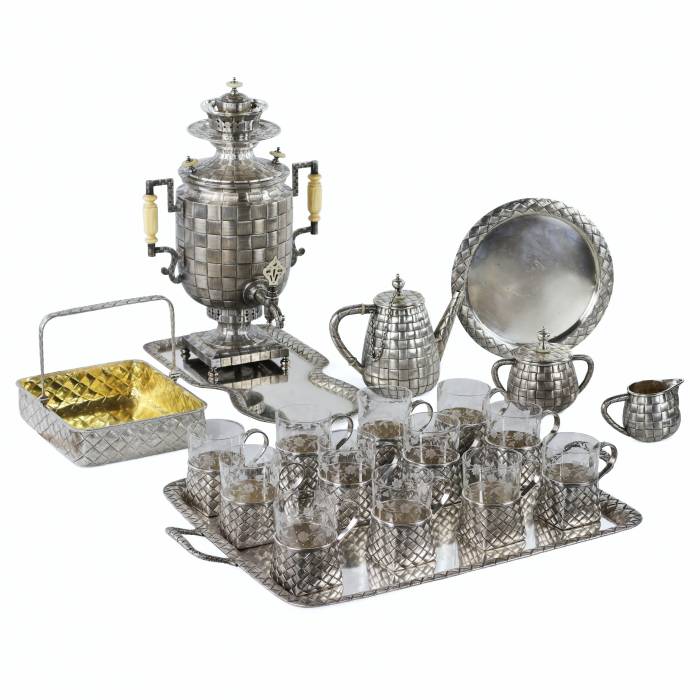
AntiqonART consultant will contact you within one business day after receiving your request.
Dimensions:
– Samovar: height – 42 cm, width – 28 cm, weight – 3029 g
– Tray under samovar: length – 42 cm, width – 23 cm, weight – 835 g
– Teapot, milk jug, sugar bowl: height – 18 cm, length – 19 cm, combined weight – 1180 g
– 12 glass holders: height – 8.5 cm, diameter – 10 cm, combined weight – 1400 g
– Large tray: length – 59 cm, width – 39 cm, weight – 2063 g
Total weight of the service: 8507 g
Marks:
Full maker’s mark of the Grachev Brothers firm, oval mark with initials JO for master jeweler Johann Ferdinandovich Olsonius, rectangular mark with initials A.M. for an unidentified silversmith, St Petersburg assay mark dated 1884 with initials of the assay master Alexander Franz von der Flit, number 84 confirming 84 zolotnik silver standard, circular mark with crossed anchors and sceptre, emblem of the St Petersburg Assay Office.
The Neo-Russian style is an artistic movement that emerged in Russia in the second half of the 19th century during a period of active search for national identity. Inspired by the aesthetics of Old Russian art, ecclesiastical architecture, and folk crafts, it developed as a reaction to the dominance of Western European canons and embodied the idea of cultural self-affirmation and revival. This style became part of a broader ideological movement aiming to restore continuity between the past and the present by merging historical memory with modern forms of artistic expression.In architecture, the Neo-Russian style was manifested in shapes reminiscent of pre-Petrine Russia: tented and domed churches, decorative kokoshniks, polychrome tiles, ornamental brickwork, and intricate carvings. In decorative arts, it featured motifs of ancient ornamentation, stylized plant forms, curvilinear lines, and traditional geometric patterns.The style gained particular momentum in jewelry. Leading workshops of the Russian Empire, including those of Carl Fabergé, Pavel Ovchinnikov, and the Grachev Brothers, embraced archaic forms and folk symbolism. Their creations often featured intricate enamels, engraving, imitation of woven textures, and decorative elements inspired by Russian folklore. These pieces became emblematic of the refined artistic culture of the late 19th and early 20th centuries, representing a synthesis of traditional craftsmanship and contemporary technological achievements.
GRACHEV BROTHERS FACTORY (1866–1918)
The Grachev Brothers Factory was one of the premier jewelry workshops of the Russian Empire, founded in Saint Petersburg in the second half of the 19th century. Having earned the prestigious title of Supplier to the Imperial Court, the factory became renowned for its superb craftsmanship, masterful work in silver, enamel, and engraving, and the incorporation of national motifs in the Neo-Russian style.The Grachev Brothers collaborated with the finest silversmiths, engravers, chasers, enamelers, and miniature sculptors, many of whom had previously worked for renowned firms such as Fabergé, Sazikov, and Ovchinnikov. Among them was Johann Olsonius, a distinguished master of Finnish origin, known for his refined artistic sensibility, exceptional detailing, and flawless execution. His works, marked with his personal stamp, stand out for their exquisite engraving and stylistic precision, making them highly prized as ceremonial and diplomatic gifts.Other notable masters at the factory included I.K. Zakharov, A.F. Martyanov, and F.L. Soldatov, whose initials are found on some of the firm’s finest creations. Thanks to this exceptional level of artistry, the Grachev Brothers’ pieces became benchmarks of Russian jewelry art at the turn of the 20th century.
JOHANN OLSONIUS (1823 – ?)
Johann Olsonius was one of the most prominent jewelers of the second half of the 19th century. A master of Finnish origin, he made a significant contribution to the development of the St. Petersburg decorative arts school. Formed at the intersection of Scandinavian craftsmanship and Russian artistic traditions, Olsonius quickly gained acclaim for his precision, clean lines, and exceptional attention to detail.He devoted much of his career to the Grachev Brothers Factory, one of the leading suppliers to the Imperial Court, creating refined silver pieces known for their stylistic restraint and technical perfection. His maker’s mark, I.O., is found on works executed in repoussé, engraving, and gilding, often in the Neo-Russian or historicist styles.In his work, Olsonius achieved a rare balance between Nordic restraint and Russian decorative richness, producing objects that were both elegant and monumental. A master of textile imitation and complex ornamental motifs, he gave particular importance to symbolism and compositional harmony.
